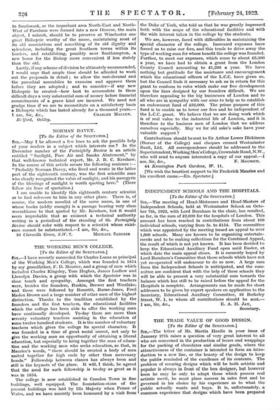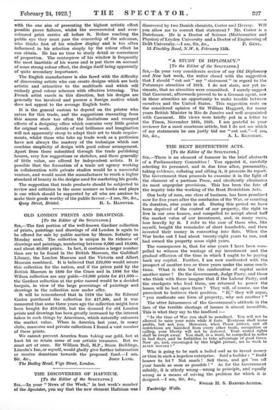1.11.E. TRADE VALUE OF GOOD. DESIGN.
[To the Editor of the SPECTATOR.] Sm,—The letter of Mr. Martin Hardie in your issue of January 27th raises a question of very great interest to all who are concerned in the production of boxes and wrappings for the packing of chocolates and similar goods, where the attractiveness of the container is intended to form an intro- duction to a new line, or the beauty of the design to keep the public reminded of the excellence of its contents. The problem of securing designs which will be both artistic and popular is always in front of the box designer, but however keen he may be only to adopt those which possess real artistic merit, he must place success in sales first and be governed in his choice by his experience as to what the public actually wants and buys. It is, unfortunately, a common experience that designs which have been prepared
with the one aim of presenting the highest artistic effect possible prove failures, whilst the overcrowded and over- coloured print carries all before it. Before reaching the public eye they must pass the censorship of the salesman, who thinks first of his window display and is too often influenced in his selection simply by the colour effect he can obtain. He has no time to study detail or correctness of proportion. The centrepiece of his window is frequently the most inartistic of his wares and is put there on account of some strong colour effect, the design itself being apparently of quite secondary importance.
The English manufacturer is also faced with the difficulty of discovering artists who can create designs which are both artistic and attractive to the multitude and which will embody good colour schemes with effective lettering. The French artist excels in this direction, but his designs are generally too involved and possess a foreign motive which does not appeal to the average English taste.
It is the general custom to depend on the printer who caters for this trade, and the suggestions emanating from this source show too often the limitations and cramped effects of a designing office which contains very little genius for original work. Artists of real brilliance and imagination will not apparently stoop to adapt their art to trade require- ments, whilst those who take up trade work as a profession have not always the mastery of the technique which can combine simplicity of design with good colour arrangement. Apart from those submitted through the trade publishing houses, very few suggestions or sketches, and these generally of little value, are offered by independent artists. It is possible that the formation of a trade art agency working in collaboration with private studios would be a successful venture, and would assist the manufacturer to reach a higher standard of beauty in the designs used for marketing his goods.
The suggestion that trade products should be subjected to review and criticism in the same manner as books and plays is one which should be supported by all who are anxious to make their goods worthy of the public favour.—I am, Sir, &c.,











































 Previous page
Previous page